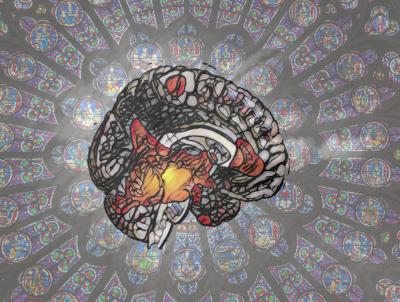With the majority of the world’s population claiming to be religious or spiritual, researchers have explored whether any correlation could be found in the brain as it relates to spirituality and its impact on brain function. Previous attempts to study spirituality were done using functional neuroimaging, where individuals performed tasks while undergoing scans that showed brain activity. The results were often inconclusive and failed to offer significant insight.
Researchers at Brigham and Women’s Hospital, led by Michael Ferguson, PhD, found that a specific brain circuit could be observed illustrating the impact of spirituality and religiosity to human brain function. The brain circuit was found to be centered in the Periaqueductal gray (PAG), located in the brainstem. The PAG has been attributed to impacting other functions, such as pain modulation and fear conditioning, as well as certain behaviors linked to emotion and altruism.
“Our results suggest that spirituality and religiosity are rooted in fundamental, neurobiological dynamics and deeply woven into our neuro-fabric. We were astonished to find that this brain circuit for spirituality is centered in one of the most evolutionarily preserved structures in the brain.” Ferguson says in a statement.
Ferguson and his team used lesion network mapping to observe the commonalities of human brain behaviors to lesions in the brain by mapping complex behaviors to specific brain circuits. Data from a previous study of 88 neurosurgical patients was used. These patients were undergoing surgery to remove brain tumors and had lesions in various parts of the brain. Prior to surgery, patients were asked questions about their spiritual acceptance.
A dataset of another 100 patients who had experienced head trauma while in combat during the Vietnam War was also used. These individuals were also asked to respond to a questionnaire about their spiritual lives.
Of the 88 patients with brain tumors, the findings reported 30 showed a decrease in self-reported spirituality, 29 showed an increase and 29 showed no change before and after the brain tumors’ removal. When the lesion network mapping technology was used, the PAG area of the brain was shown to map spirituality to this brain circuit, which included both positive and negative nodes. When lesions on the PAG were disrupted, the nodes either increased or decreased spiritual beliefs. The dataset of 100 produced similar results. When examined closely, researchers found certain instances in which patients reported an increase in their spirituality and became hyper-religious when the brain lesions affected the negative nodes of the circuit.
When observing other neurological and psychiatric conditions, like Parkinson’s disease, similar findings connecting spirituality to this particular brain circuit were found. Lesions that interacted with positive nodes of the circuit resulted in decreased spirituality, where conditions such as alien limb syndrome and delusions intersected with the negative part of the circuit, resulting in increased spirituality. Ferguson made clear the results should not be over-interpreted and that these findings do not always imply direct causation. For example, Parkinson’s disease does not arise from lack of religious faith, nor is religion a delusion.
The team also acknowledged several variables were not included in the findings which may impact a person’s spiritual tendencies. The majority of the individuals who took part in the study identified as Christians, so further research would need to be applied to individuals of different faiths to validate these findings hold true across diverse religious backgrounds. An individual’s upbringing was also not taken into account, which may have influence over religious tendencies.
With the results of the study, Ferguson and his team believe there are neurobiological functions directly tied to a person’s religious and spiritual neurofiber despite these other variables. A correlation between spirituality and healing among people of different faith backgrounds has long been intertwined. Researchers are hoping to one day translate the role spirituality plays in the human brain and explore ways this newfound understanding of brain circuitry could be used for treatment in a clinical environment.
This study is published in the journal Biological Psychiatry.
Article by Elizabeth Bartell













Comments